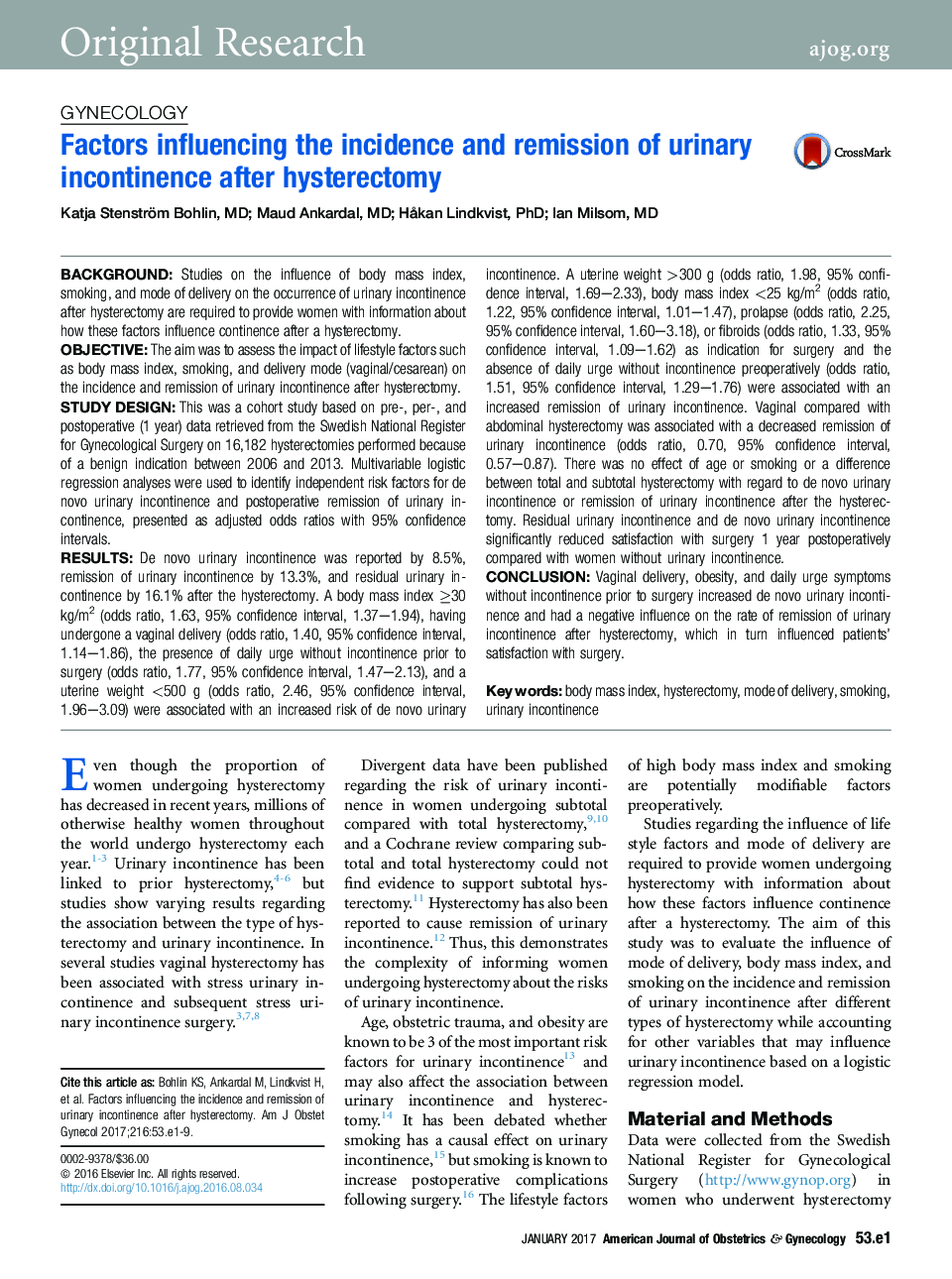| کد مقاله | کد نشریه | سال انتشار | مقاله انگلیسی | نسخه تمام متن |
|---|---|---|---|---|
| 5676347 | 1594881 | 2017 | 9 صفحه PDF | دانلود رایگان |
BackgroundStudies on the influence of body mass index, smoking, and mode of delivery on the occurrence of urinary incontinence after hysterectomy are required to provide women with information about how these factors influence continence after a hysterectomy.ObjectiveThe aim was to assess the impact of lifestyle factors such as body mass index, smoking, and delivery mode (vaginal/cesarean) on the incidence and remission of urinary incontinence after hysterectomy.Study DesignThis was a cohort study based on pre-, per-, and postoperative (1 year) data retrieved from the Swedish National Register for Gynecological Surgery on 16,182 hysterectomies performed because of a benign indication between 2006 and 2013. Multivariable logistic regression analyses were used to identify independent risk factors for de novo urinary incontinence and postoperative remission of urinary incontinence, presented as adjusted odds ratios with 95% confidence intervals.ResultsDe novo urinary incontinence was reported by 8.5%, remission of urinary incontinence by 13.3%, and residual urinary incontinence by 16.1% after the hysterectomy. A body mass index â¥30 kg/m2 (odds ratio, 1.63, 95% confidence interval, 1.37-1.94), having undergone a vaginal delivery (odds ratio, 1.40, 95% confidence interval, 1.14-1.86), the presence of daily urge without incontinence prior to surgery (odds ratio, 1.77, 95% confidence interval, 1.47-2.13), and a uterine weight <500 g (odds ratio, 2.46, 95% confidence interval, 1.96-3.09) were associated with an increased risk of de novo urinary incontinence. A uterine weight >300 g (odds ratio, 1.98, 95% confidence interval, 1.69-2.33), body mass index <25 kg/m2 (odds ratio, 1.22, 95% confidence interval, 1.01-1.47), prolapse (odds ratio, 2.25, 95% confidence interval, 1.60-3.18), or fibroids (odds ratio, 1.33, 95% confidence interval, 1.09-1.62) as indication for surgery and the absence of daily urge without incontinence preoperatively (odds ratio, 1.51, 95% confidence interval, 1.29-1.76) were associated with an increased remission of urinary incontinence. Vaginal compared with abdominal hysterectomy was associated with a decreased remission of urinary incontinence (odds ratio, 0.70, 95% confidence interval, 0.57-0.87). There was no effect of age or smoking or a difference between total and subtotal hysterectomy with regard to de novo urinary incontinence or remission of urinary incontinence after the hysterectomy. Residual urinary incontinence and de novo urinary incontinence significantly reduced satisfaction with surgery 1 year postoperatively compared with women without urinary incontinence.ConclusionVaginal delivery, obesity, and daily urge symptoms without incontinence prior to surgery increased de novo urinary incontinence and had a negative influence on the rate of remission of urinary incontinence after hysterectomy, which in turn influenced patients' satisfaction with surgery.
Journal: American Journal of Obstetrics and Gynecology - Volume 216, Issue 1, January 2017, Pages 53.e1-53.e9
